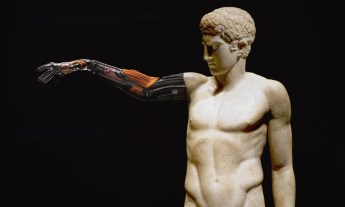
Ed Boyden is the head of the Synthetic Neurobiology group at the MIT Media Lab. He talks brains and optogenetics (a technique being used to better understand blindness and Parkinson’s disease) with futurist and venture capitalist Juan Enriquez.
Juan Enriquez: So Ed, when Obama started his big BRAIN initiative, there were serious older pooh-bas who had created the fields of neuroscience and neurobiology. What were you doing there?
Ed Boyden: I’ve always been a philosopher at heart, trying to understand things like motivation, why are we here, what are we doing. We have our minds, and they’re being implemented by our brains, which of course are made out of chemicals that are governed by the laws of physics, which we then understand with these beautiful and eloquent equations in our minds. I realized: It’s a loop. And if you really want to contribute to the understanding of something, look for the weakest point in the loop.
So while I’d started graduate school doing quantum computing — I thought physics was the most philosophical science — after a year I switched into neuroscience. I really wanted to understand how to work backwards from the properties of the brain to invent new tools that help solve the brain, using my engineering background.
At the time a lot of neuroscience groups were like, “hmm, is the brain ready for engineering?” Before this modern era of neurotechnology, there were many people who invented tools for studying or fixing the brain, but it tended to be a bit undirected. It’s gratifying to see that what was so fringe then has become so mainstream that you have the President of the United States announcing it as one of the highest scientific priorities of the day.
JE: What part of the loop are you entering at, and why?
EB: In what you might call the “loop of understanding,” the weakest links are definitely how our mind makes sense of the world and how our mind is implemented by the molecules in the brain. I decided to go after the latter topic: Can we figure out how the cells that make up our brain circuits compute?
There’s a lot of evidence that very specific parts of the brain contribute to very specific human traits, abilities and even aspects of identity, but knowing where something is located doesn’t tell you how it’s implemented. So the basic idea is to say, “Let’s take the brain and work backwards from its complexity and density, its high speed of operation and heterogeneity.” Then, can we survey all the fields of engineering, going from physics and chemistry and material science all the way to computer science and electrical engineering and systems engineering, and figure out how to build optimal technologies that could make exact measurements of, and precise control of, brain circuits?
JE: Since you entered the field, what new ways of imaging, probing and understanding the brain have been built? What are you building for tomorrow?
EB: In our group, we’ve collaborated with Craig Forest, a mechanical engineer at Georgia Tech, to build a robot that can automatically go into the brain and do surgery on single cells in the living brain. Now we can extract the contents of a cell, inject things into a cell and record the tiny little electrical pulses that you can’t see using any other technology.
Together with Clif Fonstad’s group, we’ve built three-dimensional micro-fabricated arrays using the methods of making computer chips, except now we’re making 3D brain probes that can record activity in distributed circuits. And we’re also working on new kinds of microscopes that can scan the brain very quickly, in collaboration with Peter So and his group in the department of biological engineering at MIT.
JE: Give us an update on where optogenetics has come since you gave your TED Talk.
EB: A year after I gave my talk, we collaborated with two groups, the Vanduffel group at Harvard and the Wurtz group at the National Institutes of Health. They used our optogenetic tools to change the behavior of non-human primates, turning neurons on or off. For example, when the Vanduffel group activated certain neurons in these monkeys, they reacted faster to things. This was a big milestone, because it showed that in a brain more similar to the human brain than, say, a mouse’s, you can safely and efficaciously change behavior.
On our end, we’ve been able to make our molecules a lot more light-sensitive. This is important because the less light you have to use, the better. On February 9th, we came out with a paper that showed we could use red light to do these kinds of manipulations and that we could use multiple colors of light to activate different pathways even when they’re all intermingled. Red light is important because it goes through tissue better. It’s extremely clinically important if we want to make optogenetics a true therapy.
Multiple colors are also important. If you only have one color, you can only turn one set of cells on and off — unless you want to aim the light at every tiny cell, one by one. This new study shows that we can use blue light versus red light to control two different pathways.
JE: Step back for one second. When you talk about changing behavior in primates, I think of a live monkey with a series of very thin fiber-optic-like cables pointing light at specific portions of the brain and changing behaviors. This is probably wildly oversimplified. But what kinds of behaviors are you able to change when you do that? What kind of therapies do you expect from some of these companies using optogenetics?
EB: Sensory restoration is a top priority for many. Blindness is a great initial target, clinically speaking. In patients who have lost the photoreceptors of their eye and are blind — who have diseases like retinitis pigmentosa — the rest of the eye contains cells that are spared, and you can make those cells sensitive to light. And because the retina is better understood than many circuits in the rest of the body, scientists can make very specific hypotheses about where in the eye to put light-sensitive molecules.
The group of Tobias Moser, in Germany, published an interesting paper on cochlear implants that use optogenetics. If you use electrical stimulation on a person who is deaf, you can have perhaps one or two dozen channels of acoustic frequency sensitivity; but of course our ears can hear thousands of frequencies. This group shows that if you use an optogenetic tool to make spared cells in the ear sensitive to light, and then aim the light at the nerves — whereas electricity would have gone in all directions — you could potentially enable more realistic hearing.
There’s also a desire amongst scientists to turn off parts of the brain that contribute to pathology. Take someone who has epilepsy. If you could turn off the overactive cells, maybe you could halt the seizure right when it’s beginning — or even before, if you could cancel it out. The group of Ivan Soltesz recently published a paper in which they show that you can try to detect a seizure and deliver light to the afflicted area that’s been sensitized to light, and then you can turn off that brain region for a little while, just long enough to shut down the seizure.
JE: Could you also “upgrade” people’s hearing by using some of these spared cells, using optogenetics and creating alternate circuits? Is this going to give birth to a whole series of science fiction books?
EB: Once you have a stimulator, you can connect it to different kinds of software. So potentially you could have something where you played back visual sensation into the hearing system. I don’t know what the brain would do in response to that. Maybe it would just be confused.
What has emerged over the years is a natural trajectory of human augmentation. You begin with a technology that’s aimed at the people with the greatest medical need because the risk-benefit ratio is appropriate. Then, as technologies are shown to be safe and efficacious, greater and greater populations of patients use them, and then some technologies cross over to augment and upgrade. There seems to be essentially a couple-decades trajectory. Somebody should study this process!
JE: Take off your scientist hat for one minute and put on your “gee-wouldn’t-it-be-cool-if-I-were-a-student-today” hat. What kinds of augmentation might we see from the ability to control the brain with light?
EB: A couple years ago, Itzhak Fried and colleagues found that deep brain electrical stimulation could boost memory. Right away many people were saying, “Aha! If we have patients with Alzheimer’s disease or other kinds of cognitive deficits, maybe we should try to do clinical trials to see if we can help them with memory.” If people find circuits where they can boost memory with electricity, and it’s shown to be safe and efficacious, and optogenetics is also shown to be safe and efficacious, memory is an area of cognitive enhancement that could be really interesting.
In that study scientists took seven patients who had epilepsy, and they implanted electrodes in a region of the brain called the entorhinal cortex, one of the areas where seizures are thought to originate. Then they did something that people don’t usually do: They stimulated these sites. They had people try to learn how to navigate a virtual reality maze. These patients were able to learn where they had to go in order to solve the maze better than control subjects. Meanwhile, there was a paper that came out many years ago that showed London taxi drivers have bigger brain areas that are associated with spatial learning and memory, perhaps because they have to learn all these places to become licensed as taxi drivers. Since the brain stimulation paper came out, lots of groups have been trying to figure out what kinds of memory you can augment with stimulation. So the next couple of years are going to be very interesting for memory enhancement science.
JE: Let’s get into the tools you’re developing now. I imagine something that looks like an Intel computer chip, except it would have a whole series of very tiny needles that would allow you to measure, silence or stimulate not just single neurons but also regions within the brain in very specific ways.
EB: Yeah. We call it the brain co-processor. Imagine a device that can record from single cells in many circuits throughout the brain, maybe even some day the whole brain. From these recordings, we could compute the kind of information the brain needs, in an external computer. And with devices that can beam light into 3D locations all over the brain, we can optogenetically deliver that information back to the brain, perhaps even to fix a certain computation. Over time we could even train the computer to do things that augment the brain’s performance.
Consider how computers and humans interact. We’ve gone from mainframes to personal computers to laptops to smartphones, and now people are putting computers in glasses and contact lenses. A quarter of a million people already have some sort of neural stimulator and computer implanted, for Parkinson’s or deafness mostly. The technologies that we’re building could easily collide with some of these societal and medical trends. But what we would add is a three-dimensional aspect, the ability to record and perturb cells throughout an entire 3D circuit.
JE: Where would you expect to see the first clinical trials, and when?
EB: Optogenetics require a gene therapy, so that will require a fairly elaborate set of preclinical and clinical studies, but our 3D recording probes are made of materials that have already been used in neural implants as single wires. So we’re actually cautiously optimistic. We’ve started to talk to neurosurgeons about the required safety studies. It’s dangerous to speculate, but if we do pass safety requirements, clinical trials could potentially be here in the coming several years, or even sooner.
For our single-cell recording robot, it’s interesting to think about whether we could do surgery on single cells in the operating room. If you could get data with incredible resolution, this could help speed up many of the processes that are required for mapping the brain for surgery, like how to remove the pathological parts and leave the other parts intact.
JE: When you start talking about putting robots inside the body that can get inside single brain cells and operate on single brain cells with that degree of accuracy, you’re going even beyond Fantastic Voyage.
EB: (Laughs) Well, the original prototype we built was macroscopic, as in, you can see it. It’s not going to move freely inside the body. But there are a couple of people in the group who are wondering: “Can we make tiny nano-particles that can wander around with a neural interfacing payload on them?” Those don’t yet exist. But we have lots of drugs that are single molecules or small molecules. Suppose you had something that looks like a drug but is actually a little machine, and it has the ability to send things and repair them. It could be a very transformative way to think about medicine.
JE: What are the things that most excite you and most scare you about these potential new capabilities?
EB: One thing that really excites me is understanding how the brain implements a thought or a feeling. Would it actually transform how humanity operates for the better — in the sense of things like strife and violence and irrationality — if we understood those things? Would understanding the mechanisms underlying these things let us be less governed by them? One scary part is that all technologies can be abused, which is why it’s important to make sure we’re discussing these things openly, ahead of the game.
Let’s take a good success story. I think it was in 1974, when it seemed clear you could take a gene from one organism and pop it into another. A bunch of people got together at Asilomar, in California, to work out some ideas for the regulations and restrictions and guidelines for manipulating genes. For crying out loud, you’re taking a gene from a plant and putting it into an animal or doing all sorts of mixing and matching! Now flash forward. It’s 40 years since then, and all sorts of things like insulin, human growth hormone and antibodies that treat cancer have come out of this genetic revolution. Of course, people always speculate that a new killer virus could be engineered by a renegade person, but if you look over nearly a half-century of recombinant DNA and biotechnology, it’s been a pretty big win for humanity.
Brain treatment, and if it gets to that point, brain augmentation, could not only change functions like cognition, emotion or movement, but maybe even change identity. So what we want to do for brain technology, once we really have the tools, would be to have that same kind of gathering, to discuss these things openly, in the context of the future of humanity and how we can benefit humanity. Let’s get everybody in the room and make sure that we all have a moral direction going forward.
Note: this conversation was lightly edited. It’s a continuation of a conversation the pair started onstage at TED2011. Ed Boyden is the head of the Synthetic Neurobiology group at the MIT Media Lab; Juan Enriquez is a futurist and venture capitalist. This article was published as part of our “Questions Worth Asking” series. This week’s teaser: “Should we redesign humans?”
















